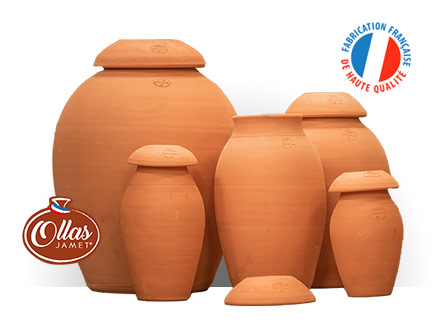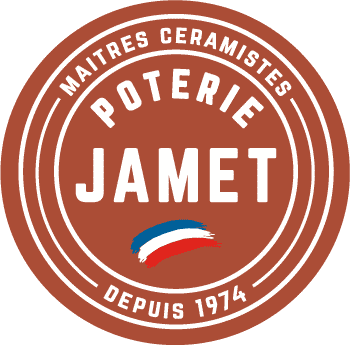Efficiency of Ollas Jamet
Advantages of Ollas compared to other irrigation systems
Bill Mollison, Australian biologist and environmentalist, Alternative Nobel Prize (Right Livelihood Award) in 1981 and other of his scientific colleagues have shown that the Ollas bring many advantages compared to other irrigation systems:
- Water savings of 50 to 75%.
- Better yields.
- Water use efficiency.
- Deep plant rooting.
- Field capacity irrigation.
- Adaptability to climate.
- Reduction of weeds.
- Can be used in saline soil.
- Simplicity, accessibility and low cost.
- Superior increase in biomass.

International tests and results
Compared to other forms of irrigation, irrigation by Ollas is very efficient, it allows water savings of more than 50% with higher yields due to the reduction of losses by evaporation and infiltration.
It also has other important advantages, such as its capacity for self-regulation or the reduction of weeds.
According to tests conducted by AE Daka, jar irrigation allows water savings of 50 to 70% compared to irrigation with a sprinkler, which is already one of the systems causing the least losses. ( AE Daka, Chapter 7 Clay pot sub-surface irrigation as water-saving technology for small-farmer irrigation in Development of a technological package for sustainable use of Dambos by small-scale farmers, PhD Thesis, P¨retoria, South Africa, University of Pretoria, 2001 ).
Indeed, sprinkler irrigation was considered to have an efficiency of 80% (i.e. 80% of the water poured used for the needs of the plant), a very high level already compared to sprinkler and surface irrigation. which have an efficiency of 65% and 50% respectively. ( Luc Arnaud, Bernard Gay, Water for market gardening, experiments and processes, Gret, Ministry of Cooperation, 1994, 128 p. – agro-planet.e-monsite.com/medias/files/de-l- water-for-market-gardening.pdf )
In tests conducted in Kenya comparing surface irrigation by furrows and by jars, the water saving was over 97% for the tested crops, tomatoes and maize. ( CC Kefa et al., “Comparison of water use savings and crop yields for clay pot and furrow irrigation methods in Lake Bogoria, Kenya”, Journal of natural sciences research, 2013 )
Yields would be higher with Ollas irrigation compared to other forms of irrigation.
In the tests of AE Daka(*), comparing the yields of 7 crops irrigated by jars, watering cans and sprinklers (sprinkling), we find that the yields per jar are generally superior to the others.
For 3 crops, yields are significantly higher +26% for turnips, +38% for cauliflower and +58% for corn).
- For beans, they are slightly higher.
- For onions and tomatoes, they are equivalent
- For cabbage, they are slightly lower
(*) AE Daka, Chapter 7 Clay pot sub-surface irrigation as water-saving technology for small-farmer irrigation in Development of a technological package for sustainable use of Dambos by small-scale farmers, PhD Thesis,, P¨retoria, South Africa, University of Pretoria, 2001
In Ethiopia, yields of tomatoes obtained with jar irrigation were 50% higher than with surface irrigation . ( CC Kefa et al., “Comparison of water use savings and crop yields for clay pot and furrow irrigation methods in Lake Bogoria, Kenya”, Journal of natural sciences research, 2013)
We are talking here about the number of kg of food produced per m3 of irrigation water used.
According to all the articles dealing with the issue, the jar irrigation system is by far the most efficient at this level.
Comparative efficiency of water use in KG/m3 (*)
- Surface irrigation by furrows: 0.7
- Sprinkler/sprinkler irrigation: 0.9
- Drip: 1.4
- Buried jars: from 2 to 7
David A. Bainbridge, Super efficient irrigation with buried clay pots, SelectedWorks, 2012
Finally, compared to other types of localized irrigation, such as drip, the technique of buried jars has the advantage of developing the roots in depth, and allows the plant to meet its needs even in case of temporary shutdown of the irrigation system.
Indeed, the nozzles of a drip irrigation being located just at the surface of the soil, this will favor the development of the roots just below the surface of the soil, but not in depth. In this case, the plants will be all the more sensitive to climatic variations and water stress.
Therefore, if the irrigation system breaks down, the plants do not have the adequate root system to fetch water from deeper depths and will wither very quickly.
Luc Arnaud, Bernard Gay, Water for market gardening, experiments and processes, Gret, Ministry of Cooperation, 1994, 128 p. (agro-planet.e-monsite.com/medias/files/de-l-eau-pour-le-maraichage.pdf)
Field capacity is the volume of water that a soil can retain in its micropores, while the macropores are drained.
This is the ideal humidity level for the plant. Beyond the capacity in the field, the plant risks suffocation because all the pores of the soil, micro and macro, are saturated.
Conversely, if the humidity level drops too much, the wilting point is reached, when the plant can no longer extract water from the soil.
Between the wilting point and field capacity is the plant's comfort zone, beyond that is water stress. (*)
(*) “Water and soil” [archive], on www.u-picardie.fr
Ollas irrigation, which automatically adapts to soil moisture, helps maintain soil moisture at the level of capacity in the field.
In contrast, conventional irrigation systems cause the soil and plants to go through cycles of too much water and then too little water.
In fact, when watering, there is too much water in the soil, making it difficult for the plant to use because its roots are submerged.
There follows a brief period when the quantity of water in the soil is at the right level to allow it to be used by plants and micro-organisms.
Finally, the water continues to infiltrate and the soil gradually dries up, reaching the threshold of withering. (**)
(**) CMC Olguín et al., Observaciones sobre el Efecto del Riego por Succión en el Rendimiento y Desarrollo del Maíz (var. H-507) en el Distrito de Riego no 41, Río Yaqui, Sonora., Chapingo, México, College of Postgraduates of Chapingo., 1966
This is why today we seek today to optimize irrigation systems by very precise calculations, sometimes supplemented by the installation of probes and tensiometers to measure the humidity of the soil. (***)
(***)“Monitoring soil moisture to improve irrigation decisions”
According to David A. Bainbridge, the use of an underground irrigation system significantly reduces the development of weeds compared to sprinkler or flood irrigation. He reports having found, during a test, 90 kg of weeds on 1 acre of land (approximately 4,000 m2) irrigated by buried jars, whereas on the same surface irrigated by flooding, there were 8.5 tons of weeds. herbs. (*)
(*) David A. Bainbridge, Gardening with less water: low-tech, low-cost techniques; use up to 90% less water in your garden, Storey Publishing, 2015, p. 128
The absence of weeds would also reduce the presence of slugs, which are major crop pests. (**)
(**) David A. Bainbridge, Super efficient irrigation with buried clay pots, SelectedWorks, 2012
The constant soil moisture maintained by the Ollas has the effect of keeping salts away from the root zone and thus allowing roots to grow in the moisture zone.
In India, yields of 27 tonnes/hectare were reportedly obtained using saline irrigation water at EC 10.2 mmhos/cm, whereas in the same area and with non-saline water, yields did not did not exceed 25 tonnes/hectare. (*)
(*) David A. Bainbridge, Super efficient irrigation with buried clay pots, SelectedWorks, 2012
Tests of the Ollas Jamet by Astredhor
Recently, the Astredhor (*) national plant technical center in Angers (France) tested the Ollas Jamet® in 2020 compared to other irrigation systems.
This study made it possible to measure and provide more details on the savings made and the benefits provided under an Oceanic / Temperate transition climate, also impacted by global warming.
The irrigation tests were carried out in the Angers region, therefore under an Oceanic / Temperate transition climate for 6 months in 2020 and 5 months in 2021.
(*) National Association of Experimentation and Horticultural Demonstration Structures.


Test results France - Oceanic and temperate climate
Use of Ollas Jamet ORIGIN in an unfavorable situation:
Systematic filling of Ollas once a week
- 250% increase in biomass
- Decrease of 56.52% of the
- water consumption
- 64.29% reduction in labor / watering frequency
- Decrease in hooping (weeding) noted but not measured
Use of Ollas Jamet ORIGIN and SPELEO in normal situations:
Filling of Ollas only when they are empty
Results to come after the next ASTREDHOR test study
Jamet pottery: 3 Ollas collections with high environmental value
Irrigation with Ollas Jamet® guarantees water and time savings, comfort of use, while having an increase in biomass, proof of the well-being of plants.
The use of Ollas Jamet® will further increase water savings and watering frequency in warmer or excessive climates compared to overhead watering systems.
